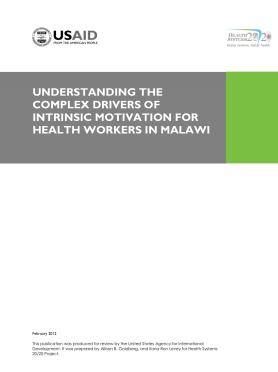Understanding the Complex Drivers of Instrinsic Motivation for Health Workers in Malawi
Understanding the Complex Drivers of Instrinsic Motivation for Health Workers in Malawi
Africa's insufficient health workforce is a major constraint in attaining the Millennium Development Goals for reducing poverty and disease (Manafa et al., 2009). The World Health Organization's (WHO) World Health Report 2006 shows that countries with fewer than 2.3 doctors, nurses, and midwives per 1,000 people fail to achieve an 80 percent coverage rate of measles immunization and the presence of skilled birth attendants during childbirth (WHO, 2006a).
Malawi, a southeast African country with a population of more than 15 million, falls far below this ratio (WHO, 2011). In 2003, it was estimated that fewer than 4,000 doctors, nurses and midwives were serving a population of approximately 12 million (Manafa et al., 2009). Given that health workers are the foundation of health service delivery (Serneels et al., 2010), the health worker shortage in Malawi has grave implications for the quality of health care delivered across the country's entire health system.
Under Malawi's health sector Programme of Work 1 initiated in 2004, Malawi implemented an Emergency Human Resource Programme (EHRP) to respond to an acute crisis in the number of health workers employed in the Ministry of Health (MOH) and Christian Health Association of Malawi (CHAM) sectors. The EHRP primarily sought to increase the production of health workers by utilizing financial incentives to improve retention and deploy health workers to remote areas, as well as substantially increase opportunities for pre-service education. In 2010, the U.K. Department for International Development (DFID) funded an evaluation of the EHRP through a contractor, Management Sciences for Health, and released a notable evaluation report. Across 11 priority cadres, the total number of health workers increased by 53 percent, from 5,453 in 2004 to 8,369 in 2009. By 2009, $34.1 million of primarily donor funds were spent to fund financial incentive payments to 8,369 public sector and CHAM health workers in select facilities (O'Neil et al., 2010).

